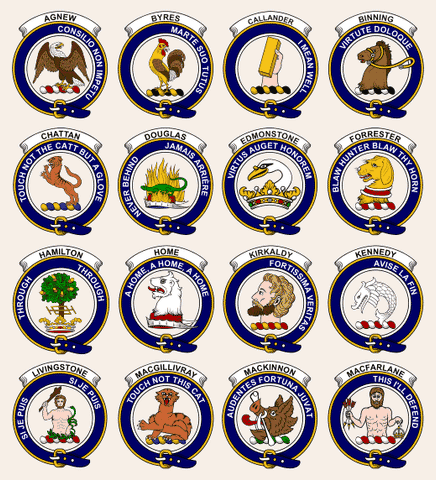
In Scotland the bearing of arms began around the same time period as in other feudal lands and for a long time followed a procedure similar to that elsewhere. The King instituted his own Heralds, usually giving the duty of Herald to the Royal Bard or Sennachie ( Gaelic for storyteller). The title Lyon is derived from the lion of Scotland who is seen in the Scottish royal arms ( see below). In a troubled land like Scotland where conspiracy was always simmering, and the Stuart Kings met with violent ends or led wretched lives, it is not surprising that no Visitations are recorded. Yet in Scotland the practice of Heraldry was to be put upon a firmer foundation than than in England. By an act of the Scots Parliament of 1672 the authority of the Lord Lyon was unquestioned and this act was confirmed by an Act of the Union Parliament of 1867. Under the Act of 1672 there was allowed a period of three months during which people could come in and register their names in the Lyon’s books, to matriculate which is the Scottish term for registering one Coat of Arms. After that date had passed the bearing of Arms in Scotland was illegal. A matriculation lasts for the lifetime of the matriculator and for that of his eldest son.

Scottish Heraldry is conducted on a strict legal and scientific basis. As the law regarding heraldic ensigns has been in force continuously for nearly 400 years a sound body of heraldic law and practice has been built up. It is the claim of the Scottish Heralds that they are more exact than the English officers. This is generally true as Scottish Heraldry follows more accurately the laws of Heraldry than England does. A good example of this is in the case of cadency. Cadency in Heraldry is the relationships of the younger to the senior members of a family and particularly to it’s head. In the Middle Ages marks of cadency were used in Coats of Arms to distinguish the degrees of seniority. The eldest son bore a label ( a rectangle bearing three pendants) on his arms during the lifetime of his father. The second son bore a crescent ( half moon), the third a mullet ( 5 pointed star), the fourth a martlet ( a bird), the fifth an annulet ( a ring), the sixth a a fleur de lis. In the Roll of Caerlaverock there are many examples of sons who bore the arms of their fathers differenced by the addition of a label of three points at the top of their shield. In English heraldry the only time you are likely to see labels on the arms are in those borne by the royal family. The present Queen, Elizabeth II, when she was Princess Elizabeth bore a label of three points argent, the center point charged with a tudor rose and each of the other points with the St. Georges Cross.



